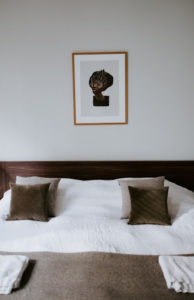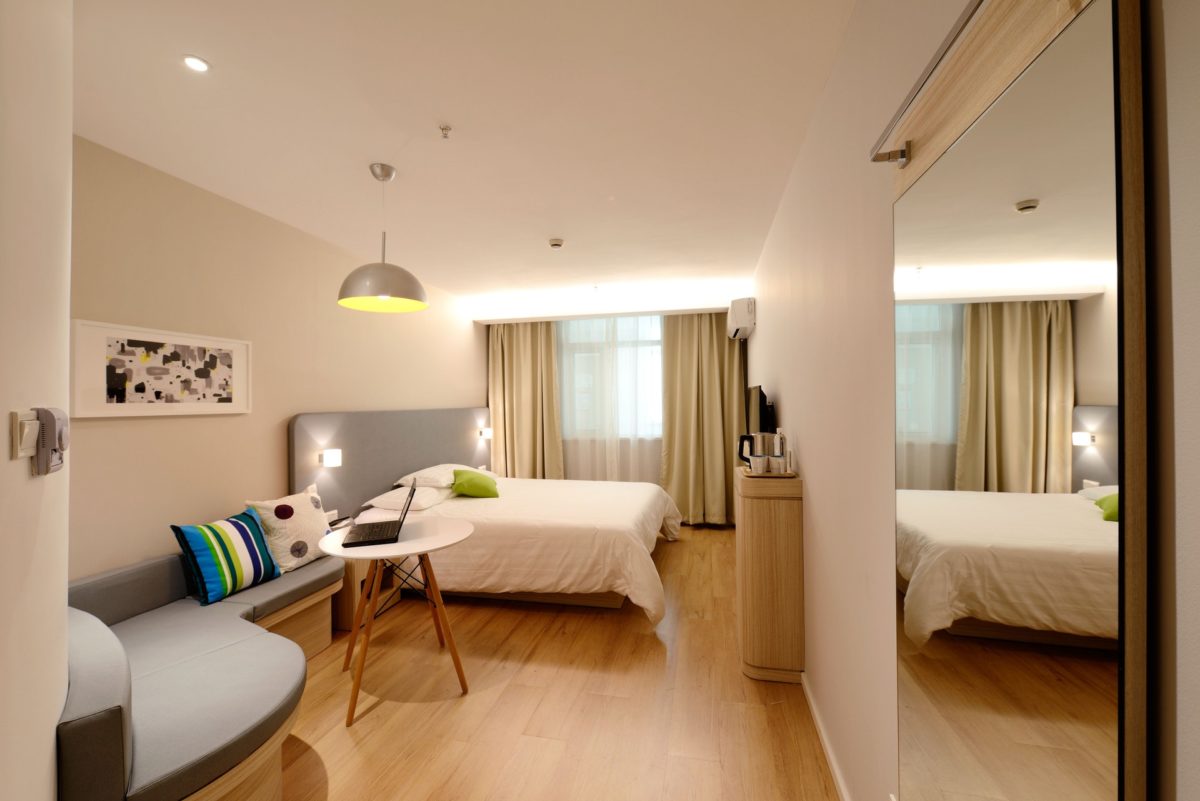In the hustle and bustle of modern life, finding moments of tranquility and relaxation has become increasingly challenging. Yet, one place that holds the potential for much-needed respite is right in our homes—the bedroom. A sanctuary of peace and serenity, the bedroom is vital in ensuring restful sleep and rejuvenation for our minds and bodies. So, find out the best ways to design your bedroom for restful sleep.
Elements Of Every Serene Bedroom
A serene bedroom encompasses several key elements of a peaceful and relaxing ambiance. One of the most crucial aspects is the choice of calming colors, such as soft blues, gentle greens, and soothing neutrals, which have positively impacted mood and sleep quality. Complementing the colors, soft and warm lighting plays a vital role in creating a tranquil atmosphere, with dimmable options and soft glow lamps being ideal choices. Integrating natural elements, such as potted plants or a small indoor fountain, brings a touch of nature indoors and promotes a sense of calmness. The bed and bedding selection are equally significant, as a comfortable mattress and high-quality pillows are essential for providing optimal support and ensuring a restful night’s sleep.
Moreover, keeping the bedroom clutter-free and organized helps eliminate distractions and fosters a sense of serenity. Investing in soundproofing materials or using white noise machines can further enhance the peaceful environment by minimizing external disturbances. Personalizing the space with cherished items and mementos adds a comforting touch, turning the bedroom into a personalized sanctuary. Regular maintenance and cleaning routines are essential to sustain the serene environment and create a space inviting relaxation.
Create The Right Color Palette
Creating a calming color palette involves careful consideration of hues that evoke a sense of tranquility and serenity. Soft and muted tones, such as pastel blues, gentle greens, and warm neutrals, are often favored for their ability to soothe the mind and instill a peaceful atmosphere. These colors can visually expand the space, making the room feel more open and inviting. When selecting the primary color, choosing one that resonates with personal preferences while maintaining a calming effect is essential. For those who prefer bolder colors, using them as accent shades in moderation can add visual interest without overwhelming the senses.
Harmonizing the colors in the room is vital to achieve a seamless and relaxing feel. One approach is to choose colors from the same family or color wheel, creating a monochromatic scheme that imparts a sense of harmony. Alternatively, selecting analogous colors adjacent to each other on the color wheel fosters a cohesive and balanced look. Understanding the psychological effects of colors is also essential; for instance, blue is often associated with tranquility and calmness, green with nature and renewal, and neutral shades with a sense of grounding and balance. Another consideration is the incorporation of natural elements into the color palette. Inspired by nature, Earthy tones can contribute to a deeper sense of serenity.
Personalizing A Serene Bedroom
This is an essential step towards creating a space that truly feels like a peaceful sanctuary tailored to one’s unique tastes and preferences. Infusing the room with personal touches adds a sense of identity and fosters a deeper emotional connection to the space, making it a place of solace and comfort. One way to personalize the bedroom is by incorporating cherished items and souvenirs that hold sentimental value. Displaying photographs of loved ones, souvenirs from meaningful travels, or artwork that resonates with the individual can evoke positive emotions and create a sense of nostalgia and happiness.
Additionally, introducing elements that reflect hobbies or interests can enhance the bedroom’s personalized ambiance. For avid readers, a cozy reading nook with a selection of favorite books can provide a tranquil escape. Embracing personal hobbies within the bedroom design allows for a space that encourages relaxation and enjoyment of individual passions. Moreover, incorporating textures and fabrics that are pleasing to the touch adds a layer of comfort and personalization. Ensuring the bedroom reflects personal style and preferences also involves selecting furniture and decor.
Choosing The Right Bedding And The Right Bed

Selecting the right bedding and bed is a fundamental aspect of when you design your bedroom for restful sleep. The bed serves as the room’s centerpiece, and its comfort and design greatly impact the overall ambiance. When choosing a bed, it’s crucial to prioritize both aesthetics and functionality. Opting for a bed frame that aligns with the bedroom’s overall style can enhance the visual appeal of the space. Equally important is selecting a mattress that caters to individual comfort and support needs. Mattresses come in various materials and firmness levels, such as memory foam, innerspring, latex, and hybrid, each offering unique benefits. While memory foam molds to the body’s contours, providing excellent pressure relief, innerspring mattresses offer enhanced breathability. Testing mattresses in-store or considering customer reviews can aid in making an informed decision.
Pillows are also integral to a good night’s sleep and should be chosen based on personal preferences and sleeping positions. Side sleepers may benefit from a firm, contoured pillow, while back sleepers may find a medium-firm pillow most comfortable. Once the bedding materials are selected, the right bed frame and mattress come into play. High-quality, soft, breathable sheets can significantly impact comfort and sleep quality. Materials like cotton and bamboo are popular for their breathability and moisture-wicking properties. Layering the bed with a cozy comforter or duvet can contribute to the overall sense of comfort and relaxation.
Soundproofing And Reducing Clutter
In pursuing a serene bedroom, soundproofing, and clutter reduction are two crucial elements often overlooked. Soundproofing the bedroom can create a peaceful oasis, shielding it from external disturbances and promoting uninterrupted sleep. Installing soundproof curtains or blinds can block out street noise and exterior lights, helping to create a calmer environment. Additionally, sealing gaps in windows and doors can further reduce noise infiltration. White noise machines or soothing sounds, like rain or ocean waves, can also contribute to a serene ambiance.
Minimizing clutter is equally essential for fostering a tranquil atmosphere in the bedroom. A clutter-free space promotes a sense of calm and enhances relaxation. Utilizing smart storage solutions, such as under-bed drawers or wall-mounted shelves, can help keep the room organized and tidy. Decluttering and utilizing pace-saving ideas for small bedrooms can come in handy when working with limited space in your home. Removing unnecessary items from surfaces, like dressers and nightstands, contributes to a visually pleasing and clutter-free environment. Embracing a minimalist approach to decor and furniture can also create an uncluttered space that encourages a clear and focused mind.
Creating A Relaxing Bedroom Routine
Crafting a relaxing bedroom routine is key to preparing both the body and mind for a restful night’s sleep. Establishing a consistent sleep schedule is the foundation of this routine, as it regulates the body’s internal clock. Setting a regular bedtime and wake-up time, even on weekends, helps maintain a balanced sleep-wake cycle. Before bedtime, engaging in calming activities can aid in winding down. Incorporating relaxation techniques, such as meditation or deep breathing exercises, can reduce stress and promote a sense of tranquility. Reading a book can also help shift the mind away from daily worries and into a state of relaxation.
Creating a soothing ambiance in the bedroom is vital to the routine. Dimming the lights and using warm lighting sources signals the brain that it’s time to wind down. Installing blackout curtains or blinds can block out external lights, ensuring a dark and restful environment. The use of electronic devices should be limited before bedtime. The blue light emitted from screens can disrupt the body’s natural sleep-wake cycle. Establishing a technology-free zone in the bedroom an hour before bedtime can facilitate a more peaceful transition into sleep.
Design Your Bedroom For Restful Sleep: Conclusion
When you design your bedroom for restful sleep, you embark on a transformative journey encompassing several essential elements. One can transform their bedroom into a true sanctuary by embracing these key elements. A thoughtfully designed bedroom improves sleep quality and enriches daily life. It provides a refuge of tranquility amid the chaos of the world, making it an invaluable investment in overall well-being.














